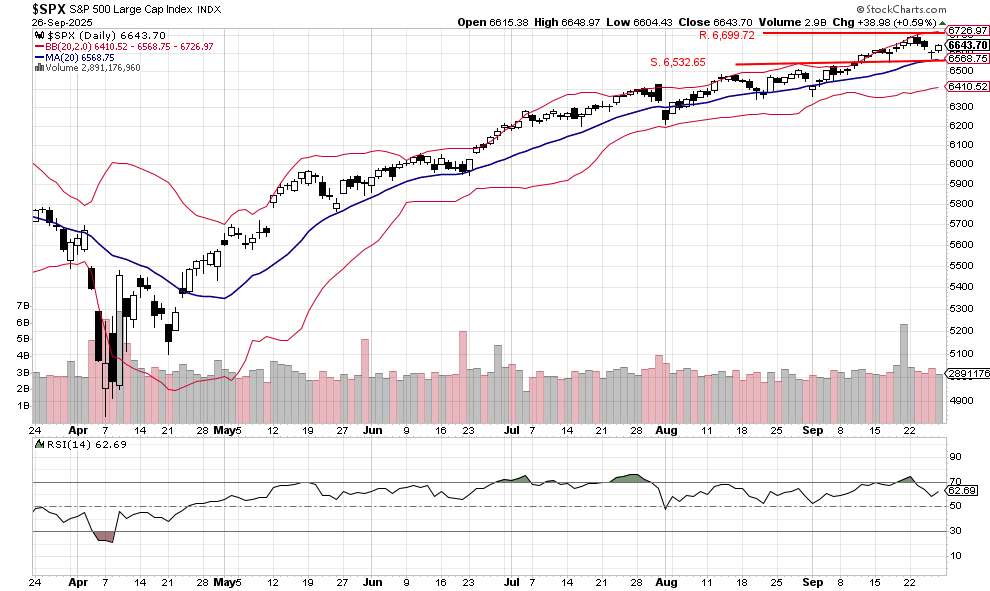Morning Brief

Headline News:
Equity futures are higher this morning after a week that saw the major averages finish with modest losses, though a strong rebound session on Friday limited the week-to-date losses as strong income and spending data supported growth hopes.
President Trump will meet with congressional leaders of both parties today ahead of the government funding deadline tomorrow night, according to Politico. President Trump has previously stated that a shutdown could result in the firing of thousands of government workers if a deal is not reached.
On the policy front, the market’s expectation for a series of rate cuts this year has been somewhat tempered in the wake of stronger-than-expected labor data and looming inflation concerns.
Cleveland Fed President Beth Hammack (FOMC nonvoting member) told CNBC that the current environment is “a challenging time for monetary policy.”
This morning’s economic data is limited to the 10:00 ET release of August Pending Home Sales, though Friday’s Nonfarm Payroll Report for September will be closely watched.
In trade developments, The Wall Street Journal reports that Chinese President Xi wants President Trump to oppose Taiwanese independence in exchange for a trade deal.
Bloomberg reports that South Korea’s National Security Adviser Wi Sung-lac stated that Seoul will not be able to pay the $350 billion investment guarantee in cash as a part of the negotiated trade deal, calling into question similar guarantees from other nations.
(Michael Gibbs, Managing Director, Lead Portfolio Manager )
Markets:
The S&P 500 rallied to close higher at 6,643.70, with the RSI index also moving higher to confirm the strength of the advance. Support at the 20-day moving average held firm, reinforcing the uptrend. Based on this momentum, we believe the S&P 500 could potentially retest the previous high at 6,699.72 later this week. However, traders should be mindful that this level may act as resistance, and a short-term pause or pullback cannot be ruled out before the index can establish a sustained move higher.
We are currently Intermediate-term cautious and short-term bullish.

John N. Lilly III CPFA
Accredited Portfolio Management Advisor℠
Accredited Asset Management Specialist℠
Portfolio Manager, RJFS
Partner, DJWMG
Windsor Wealth Planners & Strategists
Futures trading is speculative, leveraged, and involves substantial risks. Investing always involves risk, including the loss of principal, and futures trading could present additional risk based on underlying commodities investments.
The Relative Strength Index (RSI), developed by J. Welles Wilder, is a momentum oscillator that measures the speed and changes of price movements.
The percentage of stocks trading above a specific moving average is a breadth indicator that measures internal strength or weakness in the underlying index. The 50-day moving averages are used for short-to-medium-term timeframes, while the 150-day and 200-day moving averages are used for medium-to-long-term ones. Signals can be derived from overbought/oversold levels, crosses above/below 50%, and bullish/bearish divergences.
The Dow Jones Industrial Average (DJIA), commonly known as “The Dow,” is an index representing 30 stocks of companies maintained and reviewed by the editors of the Wall Street Journal. The Russell 2000 Index measures the performance of the 2,000 smallest companies in the Russell 3000 Index, which represents approximately 8% of the total market capitalization of the Russell 3000 Index.
The S&P 500 is an unmanaged index of 500 widely held stocks that is generally considered representative of the U.S. stock market. Past performance may not be indicative of future results. Keep in mind that individuals cannot invest directly in any index, and index performance does not include transaction costs or other fees, which will affect actual investment performance. Individual investors’ results will vary. Opinions expressed are those of the author, John N. Lilly III, and not necessarily those of Raymond James. “There is no guarantee that these statements, opinions, or forecast provided herein will prove to be correct. “The information contained was received from sources believed to be reliable, but accuracy is not guaranteed. Investing always involves risk, and you may incur a profit or loss. No investment strategy can guarantee success. The charts and/or tables presented herein are for illustrative purposes only and should not be considered as the sole basis for your investment decision. International investing involves special risks, including currency fluctuations, different financial accounting standards, and possible political and economic volatility. Investing in emerging markets can be riskier than investing in well-established foreign markets.
This is not a recommendation to buy or sell any company’s stock mentioned above.
US government bonds and treasury bills are guaranteed by the US government and, if held to maturity, offer a fixed rate of return and guaranteed principal value. US government bonds are issued and guaranteed due to the federal government’s timely principal and interest payment. Bond prices and yields are subject to change based on market conditions and availability. If bonds are sold prior to maturity, you may receive more or less than your initial investment. Holding bonds to term allows redemption at par value. There is an inverse relationship between interest rate movements and bond prices. Generally, when interest rates rise, bond prices fall, and when interest rates fall, bond prices generally rise.
The Nasdaq 100 (^NDX) is a stock market index made up of 103 equity securities issued by 100 of the largest non-financial companies listed on the NASDAQ. It is a modified capitalization-weighted index. It is based on exchange and not an index of U.S.-based companies.
The Russell 2000 Index is a stock market index that measures the performance of the 2,000 smaller companies included in the Russell 3000 Index. It is managed by London’s FTSE Russell Group and is widely regarded as a bellwether of the U.S. economy because it focuses on smaller companies that focus on the U.S. market.



